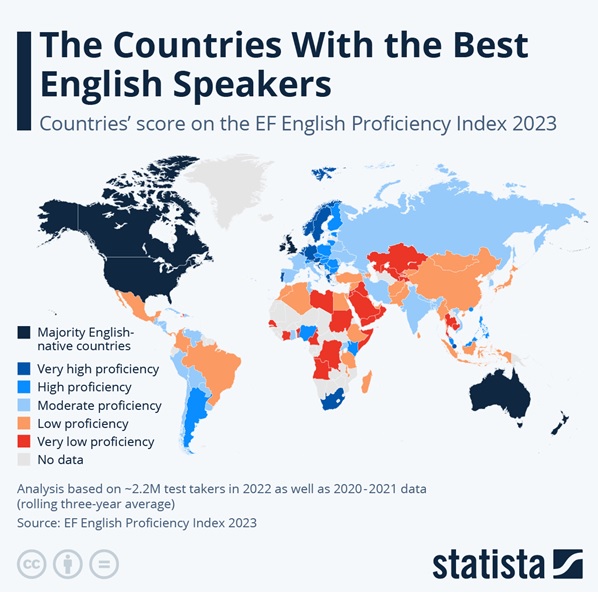India Toll Free : 1800 212 6400 | Phone : +919739615888
Email : act@asiancollegeofteachers.com | asiancollegeofteachers@gmail.com
Strategies For Enhancing English Language Learners' Proficiency Levels With CEFR And GSE Method
8th July 2024
English is a language which become more than a necessity in today’s world.
From the education industry to the business industry, it’s become one of the primary languages used to communicate globally. In the image below, we can see that there are plenty of non-native English countries which have low proficiency levels in English speaking.

Source: statista.com
However, if you are an ESL/EFL teacher who’s looking for a way to determine English-speaking abilities and skills and want to gauge their proficiency level, but don’t know how you can achieve it.
Then, no need to worry, we have got you covered. In this blog post, we will be sharing some of the English language assessment methods like- CEFR and GSE, which can help you understand English language learners’ proficiency levels properly.
What is the ELL Level of Proficiency?
To assess an English language learner’s (ELL) ability and place them in the proper class level, language institutions must first determine a student's level of proficiency. This is typically measured on a scale ranging from beginner to advanced (or native speaker level).
Understanding your student's level of competency at the start and conclusion of the class is crucial for assessing your teaching performance. It can also be used to uncover ways to better align material with students' learning objectives.
There are plenty of language assessment methods that you can use to gauge English language learners’ proficiency levels. However, there are two of the best frameworks namely- CEFR and GSE, which you can use. Let’s get to know about these frameworks in more detail.
What is The CEFR method?
Amidst there are plenty of assessment frameworks available, the Common European Framework of Reference (CEFR) has emerged as a globally recognized standard. Developed by the Council of Europe, this comprehensive scale transcends linguistic boundaries, providing a universal lexicon for describing language proficiency levels across diverse tongues.
Its widespread acceptance spans academic institutions, governments, businesses, and language schools worldwide. The CEFR's neutral descriptors have become a lingua franca, facilitating seamless communication and comparison of language abilities in professional and educational contexts.
CEFR Language Assessment Method
The CEFR outlines six distinct proficiency levels, ranging from A1 (Beginner) to C2 (Proficient). These levels are further clustered into three overarching categories: Basic User, Independent User, and Proficient User. Let’s get to know how effective it is in figuring out English language learner’s proficiency levels:
Basic User
A1 (Beginner): At this foundational level, learners possess a rudimentary grasp of English, enabling them to engage in basic introductions and respond to simple queries about their origins or age. Their interactions are limited to isolated words or short phrases like-
- How are You?
- Where Are You From?
- I am fine.
A2 (Elementary): Learners at this stage can communicate using complete sentences, drawing from a broader vocabulary and common expressions about familiar topics. However, they may still require a measured pace from conversational partners.
Independent User
B1 (Intermediate): This level equips learners with the ability to converse about subjects close to their personal interests, such as hobbies, education, or experiences. They can articulate their thoughts, dreams, and opinions, albeit in an uncomplicated manner.
B2 (Upper Intermediate): With increased fluency, learners at the B2 level can engage in essential discussions on concrete and abstract topics, including cultural and political issues. They can participate in meetings within their areas of expertise and converse with native speakers.
Proficient User
C1 (Advanced): At this advanced stage, learners demonstrate a firm grasp of complex grammatical structures, both in written and spoken forms. They can comprehend lengthy texts, determine implicit meanings, and navigate diverse situations, be it academic, professional, or social, with ease.
C2 (Proficient): The pinnacle of the CEFR scale, this level signifies near-native proficiency. Learners can communicate with exceptional fluency and precision, even when tackling intricate topics like science or finance. Their comprehension is virtually unmatched, regardless of the complexity of vocabulary or the speaker's pace.
Learn, how ESL teachers use linguistics to teach English, here:
Difference between Fluency & Proficiency
While proficiency and fluency are interlinked, they are distinct concepts. Proficiency encompasses accuracy – the correct usage of terminology, grammar, and phrasing in the target language. Fluency, on the other hand, pertains to the smoothness and articulation with which a learner can communicate coherent thoughts.
It's crucial to note that fluency does not necessarily equate to proficiency, and vice versa. A learner's fluency can fluctuate, influenced by factors such as age, experience, and instructional methods. Understanding this distinction allows educators to strike a balance between fostering fluency and cultivating accuracy.
How Can Determine CEFR Levels of Learners?
The CEFR itself is not a test but a framework for describing language proficiency levels. However, learners can ascertain their CEFR level through various assessments:
Placement Tests
Offered by language schools or institutes, these tests provide a swift evaluation of a learner's proficiency level, aiding in course placement and tracking progress.
Standardized English Proficiency Exams
Comprehensive assessments like the Pearson Test of English (PTE), International English Language Testing System (IELTS), Test of English as a Foreign Language (TOEFL), and Business Language Testing Service (BULATS) are often required for academic, professional, or immigration purposes. These exams map their results to corresponding CEFR levels.
Introducing the Global Scale of English (GSE)
Developed by Pearson Languages, a leader in language learning, the Global Scale of English (GSE) is an innovative framework designed to guide learners through every phase of their linguistic journey. Spanning a scale of 10 to 90, the GSE meticulously outlines goals and milestones for reading, writing, listening, and speaking proficiencies.
The GSE's approach to English language learners in micro-levels complements the CEFR, providing a more nuanced evaluation of progress at each stage of a learner's education. While the CEFR categorizes overall fluency, the GSE specifies what a learner can accomplish within each level regarding the four core language skills.
How Can CEFR and GSE Methods Work Together?
The CEFR and GSE methods can operate as a duo, offering an exceptionally detailed portrait of a learner's linguistic development. The CEFR serves as the overarching framework, while the GSE adds intricate brushstrokes, capturing the micro-progressions often overlooked by broad standardized tests.
Notably, the GSE was explicitly designed to align with the CEFR, ensuring seamless integration between the two systems. This harmonious interplay allows instructors to track granular advancements in student learning while adhering to widely accepted proficiency standards.
Embrace Every Learner’s Progress
While every learner's journey is unique and shaped by their prior knowledge and experiences, measuring proficiency through standardized levels is not an impossible task for ESL/EFL educators. By leveraging globally recognized frameworks like the CEFR and GSE, educators can guide their instruction and empower learners to take ownership of their linguistic progress.
As the world becomes increasingly interconnected, the ability to communicate effectively in English has become an invaluable asset. You can go through the above compressive guide to understand and embrace these proficiency benchmarks, which can help you pave the way for a more inclusive and harmonious global community, where linguistic barriers are transcended, and diversity is celebrated.
If you want to learn more effective and latest ESL/EFL teaching methods, then consider pursuing courses like TEFL in-class certification course in India, where you will get assistance from top expert trainers.
We believe education should be accessible to everyone. That’s why we don’t charge for our blogs. Find the right course that will help you in your career with us, contact us at - 1800–212–6400. You can mail us at act@asiancollegeofteachers.com.

